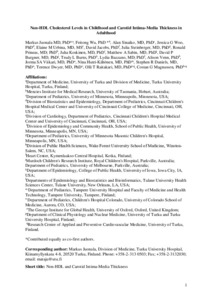Non-HDL Cholesterol Levels in Childhood and Carotid Intima-Media Thickness in Adulthood
Julia Steinberger; Matthew A. Sabin; Elaine M. Urbina; Feitong Wu; Costan G. Magnussen; Jessica G. Woo; Ronald Prineas; Juha Koskinen; Markus Juonala; Lydia Bazzano; Terence Dwyer; David P. Burgner; Stephen R. Daniels; Alan Sinaiko; Jorma S.A. Viikari; Alison Venn; Trudy L. Burns; Olli T. Raitakari; David Jacobs; Nina Hutri-Kähönen
Non-HDL Cholesterol Levels in Childhood and Carotid Intima-Media Thickness in Adulthood
Julia Steinberger
Matthew A. Sabin
Elaine M. Urbina
Feitong Wu
Costan G. Magnussen
Jessica G. Woo
Ronald Prineas
Juha Koskinen
Markus Juonala
Lydia Bazzano
Terence Dwyer
David P. Burgner
Stephen R. Daniels
Alan Sinaiko
Jorma S.A. Viikari
Alison Venn
Trudy L. Burns
Olli T. Raitakari
David Jacobs
Nina Hutri-Kähönen
AMER ACAD PEDIATRICS
Julkaisun pysyvä osoite on:
https://urn.fi/URN:NBN:fi-fe2021042822849
https://urn.fi/URN:NBN:fi-fe2021042822849
Tiivistelmä
BACKGROUND: Elevated non–high-density lipoprotein cholesterol (HDL-C) levels are used to identify children at increased cardiovascular risk, but the use of non–HDL-C in childhood to predict atherosclerosis is unclear. We examined whether the National Heart, Lung, and Blood Institute classification of youth non–HDL-C status predicts high common carotid artery intima-media thickness in adulthood.
METHODS: We analyzed data from 4 prospective cohorts among 4582 children aged 3 to 19 years who were remeasured as adults (mean follow-up of 26 years). Non–HDL-C status in youth and adulthood was classified according to cut points of the National Heart, Lung, and Blood Institute and the National Cholesterol Education Program Adult Treatment Panel III. High carotid intima-media thickness (cIMT) in adulthood was defined as at or above the study visit-, age-, sex-, race-, and cohort-specific 90th percentile of intima-media thickness.
RESULTS: In a log-binomial regression analysis adjusted with age at baseline, sex, cohort, length of follow-up, baseline BMI, and systolic blood pressure, children with dyslipidemic non–HDL-C were at increased risk of high cIMT in adulthood (relative risk [RR], 1.29; 95% confidence interval [CI], 1.07–1.55). Compared with the persistent normal group, the persistent dyslipidemia group (RR, 1.80; 95% CI, 1.37–2.37) and incident dyslipidemia (normal to dyslipidemia) groups (RR, 1.45; 95% CI, 1.07–1.96) had increased risk of high cIMT in adulthood, but the risk was attenuated for the resolution (dyslipidemia to normal) group (RR, 1.17; 95% CI, 0.97–1.41).
CONCLUSIONS: Dyslipidemic non–HDL-C levels predict youth at risk for developing high cIMT in adulthood. Those who resolve their non–HDL-C dyslipidemia by adulthood have normalized risk of developing high cIMT in adulthood.
Kokoelmat
- Rinnakkaistallenteet [19207]
